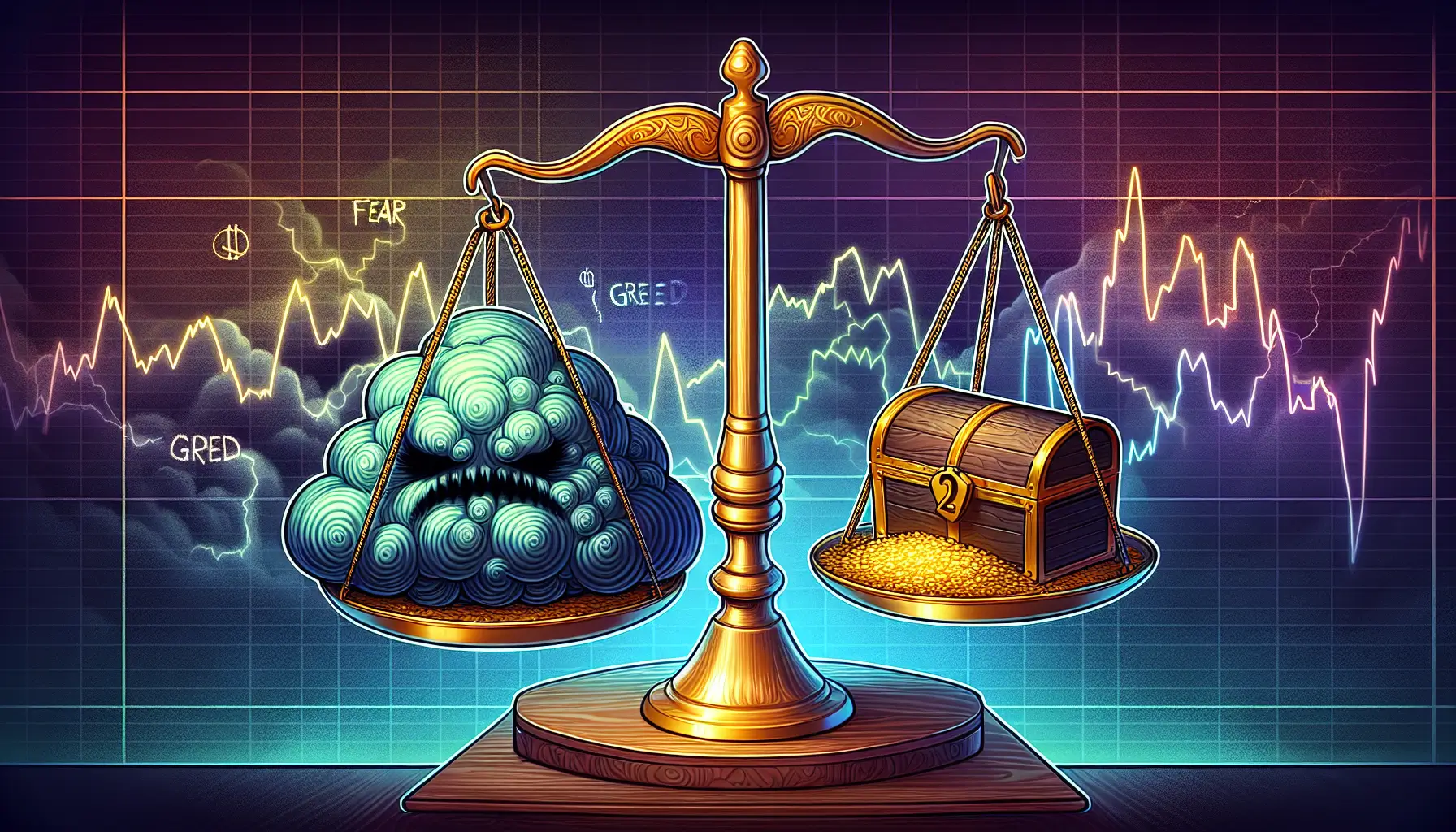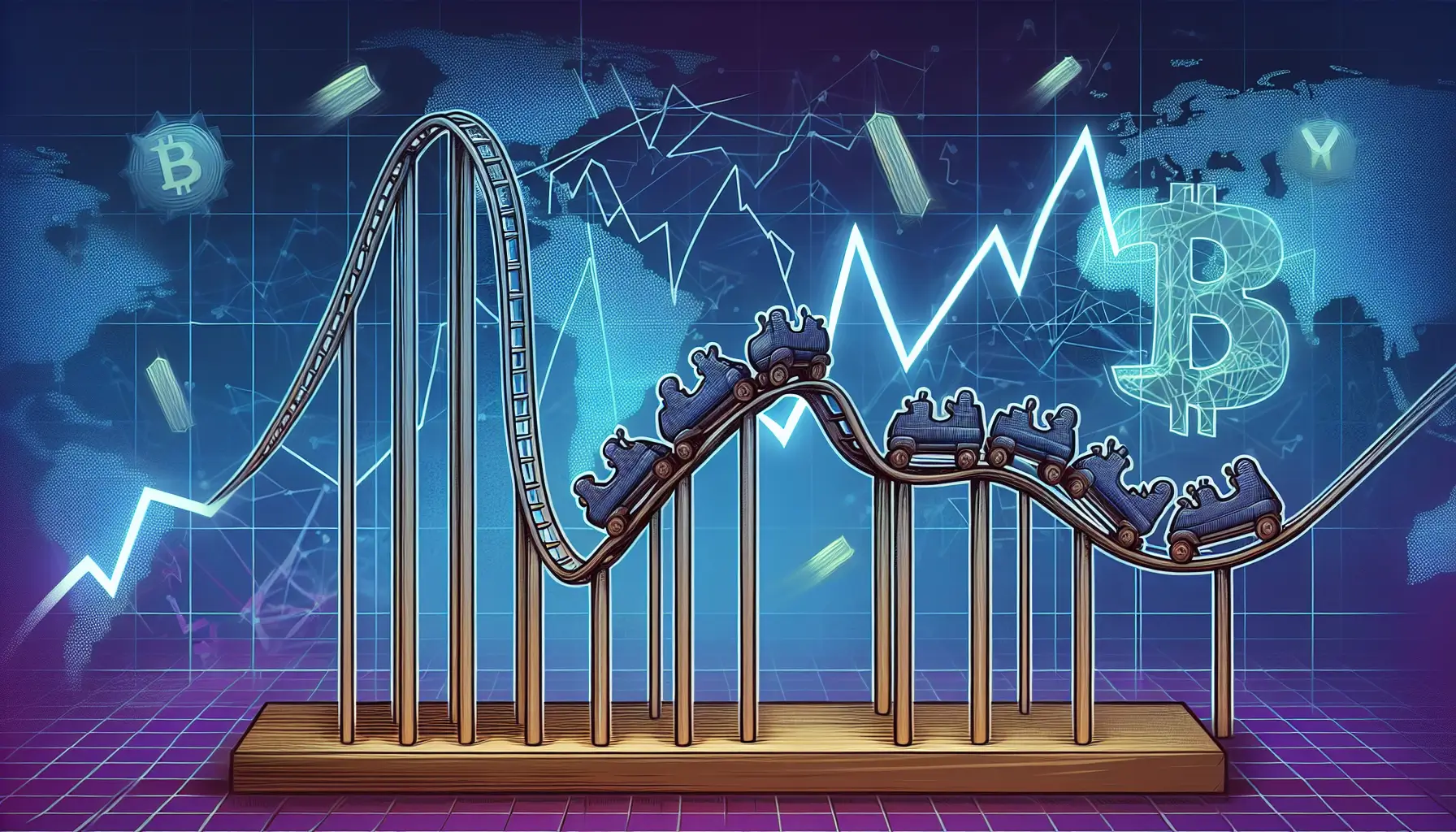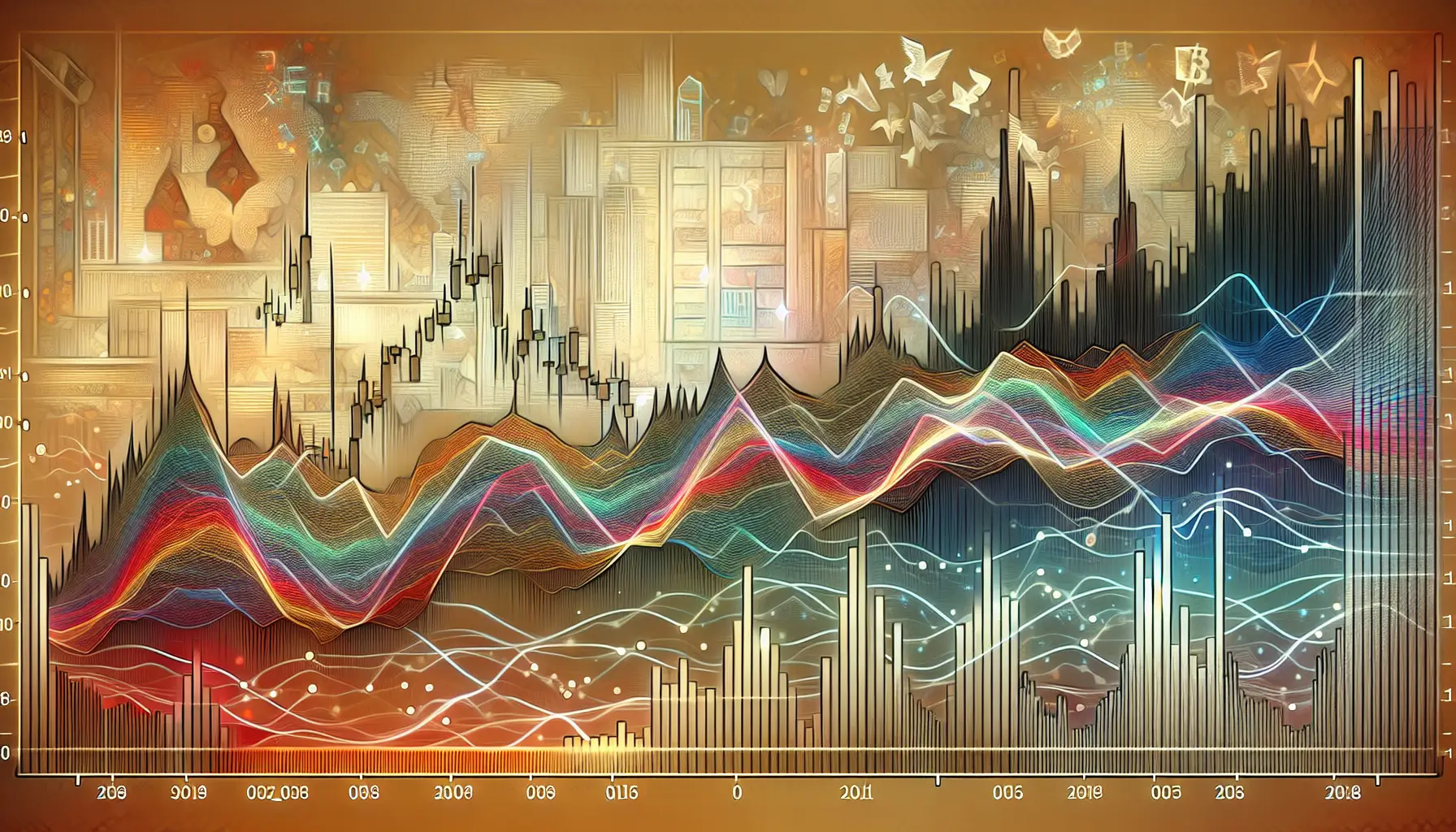If you’re actively trading or monitoring cryptocurrencies, the fear and greed index crypto offers vital clues about whether investors are currently driven by fear or greed.
This concise yet powerful metric informs you when the market emotion is ripe for buying or pulling back. In the following discussion, we’ll decode this index and show you how to utilize it effectively without oversimplifying its depth.
Key Takeaways
- The Fear and Greed Index provides a quantifiable measure of the crypto market’s emotional state, ranging from extreme fear to extreme greed, which can help inform investors’ buying and selling decisions.
- Several factors, including volatility, market momentum, trading volumes, social media sentiment, and Bitcoin’s market dominance, influence the Crypto Fear and Greed Index, shaping a comprehensive outlook of market sentiment.
- While useful for sensing market sentiment and informing investment decisions, the Fear and Greed Index should be complemented with other technical and fundamental analyses due to its limitations in predicting long-term market movements and variability.
Here’s a table summarizing the recent historical values of the Crypto Fear and Greed Index, along with a brief commentary on market sentiment based on data from various sources:
| Date | Fear & Greed Index | Market Sentiment |
|---|---|---|
| April 18, 2024 | 57 | Neutral |
| April 18, 2023 | 79 | Extreme Greed |
| April 18, 2022 | 24 | Extreme Fear |
| April 18, 2021 | 58 | Greed |
| April 18, 2020 | 62 | Neutral |
| April 18, 2019 | 93 | Bullish |
| April 18, 2018 | 62 | Neutral |
| April 18, 2017 | 100 | Bullish |
| April 18, 2016 | 85 | Bullish |
| April 18, 2015 | 8 | Bearish |
| April 18, 2014 | 50 | Neutral |
| April 18, 2013 | 88 | Bullish |
| April 18, 2012 | 91 | Bullish |
| April 18, 2011 | 100 | Bullish |
This table indicates significant fluctuations in investor sentiment over the years, reflecting cryptocurrency markets’ highly volatile and reactive nature. High values (above 50) typically indicate greed or bullish sentiment, while low values (below 50) indicate fear or bearish sentiment.
The Essence of the Fear and Greed Index in Crypto

The Fear and Greed Index, a measure that fluctuates between 0 and 100, captures the emotional state of the crypto market. At one end of the spectrum, 0% denotes extreme fear, while 100% represents extreme greed. This metric guides investors when deciding the best times to buy or sell, contributing to an informed risk management strategy.
The fear and greed index is a robust sentiment gauge within the crypto market. A high index indicates a market propelled by greed, a common scenario in a bullish trend. Conversely, a low index reflects a market dominated by fear, typically observed during a bearish trend.
This straightforward but powerful tool offers a glimpse into the market’s prevailing emotions, empowering investors to make thoughtful decisions.
Origins of the Fear and Greed Index
The Fear and Greed Index was initially introduced by CNNMoney back in 2012. It was created to measure investors’ emotions and provide a snapshot of market sentiment. The idea was to give investors a concise representation of the market mood, a tool to consolidate various indicators into a single, easily understandable measure.
The Fear and Greed Index was revised in 2018, incorporating additional indicators like junk bond demand, stock price breadth, and safe haven demand.
This modification was implemented to offer a more holistic perspective of market sentiment, thereby enhancing the index’s comprehensiveness and value for investors.
Crypto Market Adaptation
In the context of the crypto market, the Fear and Greed Index assumes an extra layer of interpretation. The index tracks the dominance of Bitcoin in the cryptocurrency market as an indicator of market sentiment.
An increase in Bitcoin’s market dominance usually signals fear. In times of fear, investors generally gravitate towards Bitcoin, deemed safer than the highly speculative altcoins. Conversely, decreasing Bitcoin’s market dominance suggests a wave of greed.
This usually corresponds to investors shifting their focus to more speculative altcoins to make a profit.
Factors Influencing the Crypto Fear and Greed Index

Several factors influence the Fear and Greed Index. The index measures the overall sentiment in the cryptocurrency market, assigning a numeric value that spans from extreme fear to extreme greed. This index is calculated using several data points, such as:
- Volatility
- Social media interactions
- Market Momentum
- Bitcoin dominance
- Search queries
Many investors often overlook the significance of market momentum and trading volumes. When the market momentum is high and trading volumes are up, it indicates greed. Conversely, declining momentum and lower volumes suggest fear, affecting the index’s score. Nonetheless, the Fear and Greed Index isn’t an all-encompassing tool.
Other factors, including technological advancements, adoption rates, regulations, and macroeconomic variations, should also be considered when analyzing cryptocurrency market sentiment.
Crypto Price Volatility
Crypto price volatility is a key factor affecting the Fear and Greed Index. In cryptocurrency, volatility is more of a rule than an exception. A sudden spike in volatility frequently signals a fearful market.
Higher market volatility indicates a riskier environment, which can amplify bullish and bearish sentiments among investors. This can lead to rapid and unpredictable price fluctuations. It means greater greed in a bull market and greater fear in a bear market. In essence, extreme volatility in cryptocurrency prices is considered an indicator of fear in the market.
Contrarily, robust market momentum, stock price strength, and elevated volumes hint at extreme greed.
Market Momentum and Trading Volume
Market momentum and trading volumes are crucial determinants affecting the Fear and Greed Index. Greed is often linked with high market momentum, while a decline in momentum tends to signal fear in the crypto market.
Trading volume can serve as an indicator of sentiment intensity. Here are some key points to consider:
- Elevated volumes often point to greed or panic
- Reduced volumes typically denote fear, particularly in bear markets
- A rise in Bitcoin’s market dominance generally is a sign of fear in the crypto market
- A decline in Bitcoin’s market dominance implies potentially greedy market behavior.
Social Media Sentiment
Recognizing the substantial role of social media in molding market sentiment, the Fear and Greed Index incorporates this factor. The index includes social media sentiment to reflect current market emotions in the crypto market.
The index employs tools that analyze Twitter sentiment to evaluate the platform’s volume and quality of interactions. An unusually high interaction rate on Twitter is often interpreted as a sign of greedy market behavior.
Cryptocurrency traders leverage trading advice and insights from social media sentiment to discern market sentiment and make more enlightened investment decisions.
Google Trends and Search Volume
Google Trends data is another component of the Fear and Greed Index, used to assess public interest in Bitcoin as a measure of market sentiment. Google Trends sheds light on the popularity of Bitcoin-related search queries. These insights are then factored into the Fear and Greed Index for market sentiment analysis.
For instance, an increase in search terms like ‘Bitcoin price manipulation’ suggests market fear, while searches for ‘Bitcoin price prediction’ indicate a bullish sentiment among investors.
This insight into public interest and sentiment towards Bitcoin is crucial to the Fear and Greed Index.
How to Interpret the Crypto Fear and Greed Index

While understanding the Fear and Greed Index is crucial, interpreting it accurately is equally important. The index is a vital instrument assisting investors in comprehending and maneuvering through the collective market sentiment. However, it should not be mistaken for an absolute forecaster of market movements. Instead, it is a guide for engaging and disengaging with the market.
The index is frequently used as a short-term measure that responds to market fluctuations and news events. However, it’s not a reliable tool for long-term market predictions.
This is why it’s often paired with other technical and fundamental analyses for a more comprehensive market view.
Extreme Fear vs. Extreme Greed
Extreme fear and extreme greed represent the two extremes of the Fear and Greed Index. Specific search terms such as ‘Bitcoin price manipulation’ reflect extreme fear in the market, which reveals a likelihood of investor concerns over fairness and valuation in the market.
A low Crypto Fear and Greed Index score corresponds to this extreme fear, implying that the market might be undervalued, presenting potential buying opportunities.
On the other hand, terms like ‘Bitcoin price prediction’ can signal extreme greed, indicating a bullish sentiment and possibly heightened market speculation. A high Fear and Greed Index score signifies extreme greed, suggesting that the market might be overvalued or on the brink of a speculative bubble.
Grasping the implications of the fear and greed extremes provides key insights into market sentiment, aiding investors as they traverse the volatile terrain of cryptocurrency investing.
Identifying Market Cycles
The Fear and Greed Index also serves as a handy tool for detecting market cycles. During long-term bull markets, the Crypto Fear and Greed Index may consistently show greed or extreme greed, reflecting prolonged positive investor sentiment. Investors use the index’s extreme values to pinpoint potential market reversals.
Extreme fear often aligns with market bottoms, and extreme greed coincides with market tops in the stock market. However, levels of extreme greed do not necessarily precipitate immediate market corrections.
This suggests that the investor behavior gauged by the index may not invariably result in predictable market reversals.
Practical Applications of the Fear and Greed Index in Crypto Investing

The Fear and Greed Index measures market sentiment and has a pragmatic role in crypto investing. It aids investors in recognizing market trends, which can guide them in timing market entry and exit more effectively.
Additionally, investors can employ the Fear and Greed Index to signal when to execute strategies such as setting stop-loss orders, thereby managing risk in tandem with the prevailing market sentiments.
Contrarian Investing Strategy
Contrarian investing is one strategy that leverages the Fear and Greed Index. In this strategy, investors do the opposite of the general market sentiment – they buy when others are selling and sell when others are buying.
Investors may find lucrative opportunities to acquire undervalued assets when the index points to lower crypto prices during periods of extreme fear.
Conversely, when ‘Extreme Greed’ is indicated by the Fear and Greed Index, hinting at an overbought market, it might be a suitable time for investors to sell or tread carefully.
Combining with Other Indicators
The Fear and Greed Index can be paired with other indicators for a more exhaustive analysis. Pairing the Fear and Greed Index with dollar-cost averaging brings about a more disciplined approach to investing.
The Fear and Greed Index can validate and strengthen asset buying or selling timing when used with technical analysis. Moreover, using the Fear and Greed Index and technical indicators like the Relative Strength Index enhances the understanding and application of market sentiment data.
Limitations and Critiques of the Fear and Greed Index
Despite its manifold advantages, the Fear and Greed Index has its limitations. The index’s ability to predict future market movements may not be reliable and often needs additional verification through other forms of analysis for prudent investment decisions.
Regarding consistency, the utility of the Fear and Greed Index is limited for long-term market trend analysis and can exhibit significant month-to-month variation.
As a result, traders often supplement the insights from the Fear and Greed Index with additional technical and fundamental analyses to improve investment accuracy.
Case Studies: The Fear and Greed Index in Action

The Fear and Greed Index has proven its ability to mirror market sentiment through historical trends, aligning with significant price movements in cryptocurrency. For example, the Fear and Greed Index skyrocketed to 92, indicating extreme market greed, when Tesla announced its Bitcoin investment in February 2021.
Likewise, after about nine months of market ‘fear’, the Fear and Greed Index shifted to ‘neutral’ as Bitcoin’s price soared past the $20,000 threshold. When Bitcoin’s price climbed over $49,000, among other instances, the Fear and Greed Index showed ‘extreme greed’ readings, reflecting a sentiment akin to its all-time high of around $69,000 in November 2021.
Summary
In conclusion, the Fear and Greed Index is a valuable tool in the crypto investment landscape. It provides a snapshot of market sentiment, helping investors navigate through the emotional highs and lows of the market.
Whether used as a standalone measure or with other indicators, it provides crucial insights into market trends and investor behavior.
However, as with any tool, it should be used wisely and in conjunction with other forms of analysis for a more comprehensive and accurate investment strategy.

Frequently Asked Questions
What is the Fear and Greed Index in crypto?
The Fear and Greed Index in the crypto market ranges from 0 to 100, reflecting the emotional temperature of the market. This index helps investors make informed buying, selling, and risk management decisions.
How is the Fear and Greed Index calculated?
The Fear and Greed Index is calculated using data points like volatility, social media interactions, market momentum, Bitcoin dominance, and search queries. It provides a comprehensive view of market sentiment.
What do extreme fear and greed signify in the Fear and Greed Index?
Extreme fear represents a low Fear and Greed Index score, signaling that the market might be undervalued. On the other hand, extreme greed corresponds to a high index score, indicating that the market may be overvalued or approaching a speculative bubble.
How can the Fear and Greed Index be used in investing?
The Fear and Greed Index can be used in investing to recognize market trends, time market entry and exit more effectively, and implement strategies based on prevalent market sentiments. It helps investors make informed decisions.
What are the limitations of the Fear and Greed Index?
The Fear and Greed Index may not reliably predict future market movements and requires additional validation through other forms of analysis for sound investment decisions. Additionally, its utility is limited for long-term market trend analysis.







